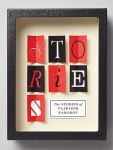Judith Jones, author of THE TENTH MUSE, as well as the recently-published THE PLEASURES OF COOKING FOR ONE, has offered to share two of her favorite recipes this holiday season. Whether you take a breather and indulge yourself in the midst of the holiday rush, or save these gems for when things quiet down, enjoy!
Fillet of Fish in Parchment
Making a parchment envelope in which to steam a fillet of fish surrounded by aromatic vegetables may sound a bit fancy for just one, but cooking in parchment is actually one of the simplest and most effective ways of steaming, because it seals in the flavors. What a treat it is to have that golden- tinged, puffed- up half- moon of parchment on your plate, and then to tear it open and breathe in all the heady aromas. Moreover, you’ll have no cleanup afterward; just wipe off the Silpat mat and throw away the parchment after you’ve scraped and scooped up every last delicious morsel and its jus.
If you want just one meal out of this, get about a 6- ounce fillet of flounder, halibut, salmon, red snapper—whatever looks good. Or, as I did recently, try tilapia, which is quite readily available these days and at a reasonable price. But I bought almost twice the amount I needed, so I could play with the other half of the cooked fillet a couple of days later.
I learned from Katy Sparks, whose book, Sparks in the Kitchen, is full of great cooking tips from a chef to the home cook, the trick of pre- roasting several slices of new potato so they can go in the parchment package. This way you have a complete, balanced meal- in- one cooked all together.
WHAT YOU NEED
- Olive oil
- 2 or 3 smallish new potatoes, cut into 1⁄2- inch slices
- Salt and freshly ground pepper
- 6- ounce fillet of flounder, halibut, tilapia, salmon, or red snapper, or more if you want leftovers
- About 1⁄3 medium zucchini, cut into julienne strips
- 1⁄2 medium carrot, peeled and cut into very thin julienne strips
- 1 scallion, white and tender green, cut into lengthwise strips
- 3 slices fresh ginger approximately the size of 25- cent pieces, peeled and cut into julienne strips
- A splash of white wine
- A sprinkling of fresh herbs, if available (such as parsley, chives, tarragon, or summer savory)
Preheat the oven to 425°.
Oil lightly the center of your Silpat mat set on a baking sheet, or, if you don’t have the mat, oil a piece of foil. Scatter the potato slices over the oiled area, then turn them. Salt and pepper lightly. Roast in the preheated oven for 10 minutes, turning once.
 Meanwhile, cut off an 18- inch piece of parchment paper, and fold it in half. Open it up, and on one half place the fish alongside the folded edge, after salting and peppering it on both sides (see illustrations on preceding page and opposite). Pile the zucchini, carrot, scallion, and ginger on top of the fish, salt again lightly, and splash on enough wine to bathe the fillet(s) lightly. After the potato slices have had their 10- minute pre- roasting, arrange them on top or around the edge of the fish and sprinkle the herbs over all.
Meanwhile, cut off an 18- inch piece of parchment paper, and fold it in half. Open it up, and on one half place the fish alongside the folded edge, after salting and peppering it on both sides (see illustrations on preceding page and opposite). Pile the zucchini, carrot, scallion, and ginger on top of the fish, salt again lightly, and splash on enough wine to bathe the fillet(s) lightly. After the potato slices have had their 10- minute pre- roasting, arrange them on top or around the edge of the fish and sprinkle the herbs over all.
Fold the other half of the parchment over, then fold in the open edge twice, and pleat it all around to make a semicircular airtight package.
If it tends to open up where the folded edges meet, secure that place with a binder clip or a large paper clip. Place on the sheet pan, and bake for 12 minutes. If you have a fairly thick fillet, you may need to bake it 1 or 2 minutes more. Test with a skewer; if it goes in easily, the fish is done.
Plunk the whole parchment package on a big dinner plate, and enjoy.
NOTE: If you deliberately cooked more fish than you need, remove what you won’t want the first time around, and save it for a second round.
SECOND ROUND
You can make a delicious salad with the remaining fish. Arrange a bed of watercress or young arugula leaves on a salad plate, and set the fish on top. Spoon 2 or 3 tablespoons of Sauce Gribiche over it (see page 160), or, if you don’t have that handy, use about 2 tablespoons mayonnaise thinned and tarted up with a little plain yogurt or lemon juice and seasoned with a small, finely chopped cornichon (or part of a dill pickle) and ½ teaspoon capers. Garnish with some strips of roasted red pepper—your own (see page 242) or from a jar—a few black olives, and some cherry tomatoes. Or try the Fish Salad recipe on page 157. These are just suggestions. Use your imagination, based on what you may have on hand.
 Boeuf Bourguignon
Boeuf Bourguignon
Make this rich stew on a leisurely weekend. You’ll probably get a good three meals out of it, if you follow some of the suggestions below. When buying stew meat at a supermarket, you don’t always know what you are getting, so ask the butcher. If it’s a lean meat, it will need less time cooking (in fact, it will be ruined if you cook it too long), but the fattier cuts can benefit from at least another half hour.
WHAT YOU NEED
- 2 ounces bacon, cut into small pieces, preferably a chunk cut into little dice
- About 11⁄4 pounds beef stew meat, cut into 1- to 11⁄2- inch pieces
- 1 tablespoon light olive oil
- 1 medium onion, diced
- 1⁄3 carrot, thick end, peeled and diced
- 2 teaspoons all- purpose flour
- Salt
- 1 cup red wine
- 1 cup beef broth
- Herb packet of 1⁄2 bay leaf; a fat garlic clove, smashed; a small handful of parsley stems; 1⁄4 teaspoon dried thyme; 4 or 5 peppercorns
Vegetable Garnish:
- 3 or 4 baby onions, or four 1- inch pieces of leek
- 3 or 4 baby carrots, or the thin ends of larger ones, peeled
- 2 or 3 small new potatoes
Brown the bacon in a heavy pot, fairly deep but not too large. When it has released its fat and is lightly browned, remove it to a dish, leaving the fat in the pan.
Pat the pieces of beef dry with a paper towel. Pour the oil into the pot, and when it is hot, brown half the pieces of beef on all sides. Remove to the plate with the bacon, and brown the remaining pieces.
Now sauté the onion and the carrot until they are lightly browned.
Return the meats to the pot, sprinkle on the flour and some salt, and pour the wine and beef stock in. Tuck the herb packet into the pot, and bring to a boil; then reduce the heat, cover, and cook at a lively simmer for about 1 hour or more, depending on the cut of the meat. Bite into a piece to determine if it is almost done (it will get another 20 minutes or so of cooking with the vegetables).
When the time is right, add all the vegetables, cover, and cook at a lively simmer again for 20–25 minutes—pierce the veggies to see if they are tender. Serve yourself four or five chunks of meat, with all the vegetables, and a good French bread to mop up the sauce.
SECOND ROUND
Use three or four pieces and some of the remaining sauce to make a quick Beef and Kidney Pie (page 34) later in the week. The recipe follows Veal Kidneys in Mustard Sauce because you want to use the leftover kidneys to put this dish together.
THIRD ROUND
Use what remains to make a meaty pasta sauce for one, breaking up the meat and adding three or four squeezed San Marzano plum tomatoes. Simmer the sauce as the pasta cooks.
 More Americans watch the Super Bowl than vote in presidential elections.
More Americans watch the Super Bowl than vote in presidential elections.





















 Meanwhile, cut off an 18- inch piece of parchment paper, and fold it in half. Open it up, and on one half place the fish alongside the folded edge, after salting and peppering it on both sides (see illustrations on preceding page and opposite). Pile the zucchini, carrot, scallion, and ginger on top of the fish, salt again lightly, and splash on enough wine to bathe the fillet(s) lightly. After the potato slices have had their 10- minute pre- roasting, arrange them on top or around the edge of the fish and sprinkle the herbs over all.
Meanwhile, cut off an 18- inch piece of parchment paper, and fold it in half. Open it up, and on one half place the fish alongside the folded edge, after salting and peppering it on both sides (see illustrations on preceding page and opposite). Pile the zucchini, carrot, scallion, and ginger on top of the fish, salt again lightly, and splash on enough wine to bathe the fillet(s) lightly. After the potato slices have had their 10- minute pre- roasting, arrange them on top or around the edge of the fish and sprinkle the herbs over all. Boeuf Bourguignon
Boeuf Bourguignon








